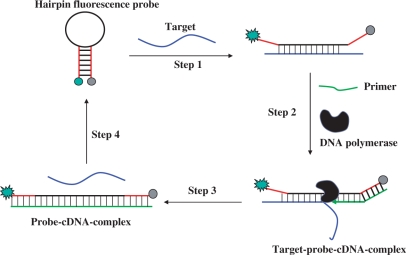Figure 1.
The mechanism of isothermal amplified detection of DNA based on strand-displacement polymerization reaction. In the presence of target DNA, the hairpin fluorescence probe recognizes and hybridizes with it and undergoes a conformational change, leading to stem separation (Step 1). Following this, the primer anneals with the open stem of the hairpin fluorescence probe and triggers a polymerization reaction in the presence of dNTP/polymerase (Step 2). Next, in the process of primer extension, the target is displaced by the polymerase with strand-displacement activity, after which a complementary DNA is synthesized, forming a probe–cDNA complex (Step 3). Finally, to renew the cycle, the displaced target hybridizes with another hairpin fluorescence probe, which triggers yet another polymerization reaction (Step 4).

